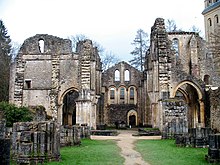Orval Abbey
| Orval Trappist Abbey | |
|---|---|
 New abbey |
|
| location |
Belgium Province of Luxembourg |
| Lies in the diocese | Namur |
| Coordinates: | 49 ° 38 '23.4 " N , 5 ° 20' 56.7" E |
| Serial number according to Janauschek |
53 |
| founding year | 1132 |
| Year of dissolution / annulment |
1796 |
| Year of repopulation | 1926 |
| Mother monastery | Trois-Fontaines Monastery |
| Primary Abbey | Clairvaux Monastery |
| Congregation | (Trappists) |
|
Daughter monasteries |
1702: Düsseltal Abbey |
The Orval Abbey (Latin Abbatia Aureavallis / BM de Aurea Valle ; German Güldenthal Abbey ) is a monastery of the Trappist Order (Cistercians of the strict observance) in the area of the municipality of Florenville in southern Belgium near the border with France . The name is derived from Basque ar (an) and French val (both meaning valley). The folk etymological interpretation of French or (as golden valley) created a legend according to which a Countess Mathilde (in some versions Mathilde of Tuszien ) lost her golden ring in the valley, which was then brought back to her by a fish. She founded the monastery out of gratitude. The Mathildenbrunnen can be visited in the ruins of the old monastery.
history
With the arrival of seven Cistercian monks on March 9, 1132, a new monastery community with a few already existing canons was created who used the buildings around a church consecrated in 1124, but got into economic difficulties. Founded in the 12th century, the monastery soon became very wealthy. Orval was considered one of the richest abbeys in the empire . So in the 18th century the plan for a complete, enlarged new building with a baroque garden , which had to give way to the medieval monastery complex , arose . The old buildings were partially demolished and half of the new facility was built.
During the First Coalition War , Orval was looted, burned and abandoned by French troops under the command of General Louis Henri Loison on their invasion of the Austrian Netherlands in 1793 . After the annexation by France in 1797, the land and forest holdings, buildings, the bank, the mines and the villages of the abbey were privatized.
The abbey was revived in the 20th century by Trappists from the Sept-Fons monastery . In 1926 the planning of the reconstruction began, financed by private donations. The cellars of the new baroque building from the 18th century were rebuilt, albeit in a simple architecture. The ruins of the destroyed medieval monastery have been preserved as a memorial and can be visited.
Todays situation

The abbey is located near the village of Villers-devant-Orval , part of the municipality of Florenville-sur-Semois .
In the abbey ruins , visitors learn more about the life of the monks in video lectures. In front of the ruins is a tool shed that was used as a workshop for the painter monk Abraham von Orval . From the church the arches and walls of the nave, the apse , the transepts and the Gothic and Romanesque column capitals have been preserved. In the center of the choir is a replica of the tomb of the first Duke of Luxembourg, Wenceslaus I. In the monastery building itself is the tomb of Bernard de Montgaillard , the most famous abbot of Orval. The monastery has its own museum in the vaulted cellar, which provides information about the history of the monastery.
The new monastery complex is not open to the public. A turret at the Almosenhof offers a special view of the complex. The main courtyard is in the middle of the complex. From here a wide flight of stairs leads up to the new monastery church. This is dominated by a 17 meter high statue of the Virgin Mary. Construction of the church began in 1926. In 1939 the church was given the status of a minor basilica , and the church was not consecrated until 1948. Czechoslovak marble was used for the interior, as well as for the abbey and the side chapels.
Remarkable
Trappist beer , cheese, and bread made in the abbey are for sale. The beer also bears the name Orval and is sold throughout Belgium and also in Germany. It has a complex taste that is emphasized by hop bitterness.
literature
- Orval Abbey . Editions Abbaye d'Orval, Villers-devant-Orval 1987.
Web links
- Official homepage of the abbey (French, Dutch, English)
Individual evidence
- ↑ Website: History of Orval , accessed on March 8, 2011
- ↑ Basilique Abbatiale Notre-Dame d'Orval on gcatholic.org
